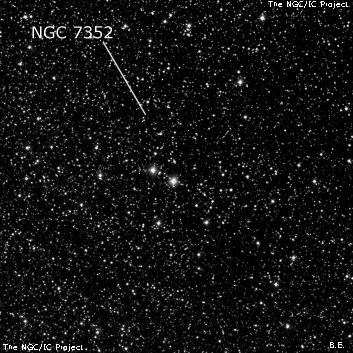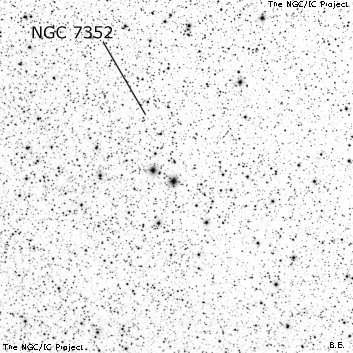NGC/IC Project Restoration Effort
(This is a very very beta version)
NGC7352


Basic Information
Location and Magnitude
Right Ascension: 22:39:44.2
Declination: +57:23:6
Constellation: CEP
Visual Magnitude:
Historic Information
Discoverer: Herschel J.
Year of discovery: 1829
Discovery aperture: 18.3
Observational
Summary description: Cl, vL, pRi, vlC
Sub-type: *Grp
Corwin's Notes
=====
NGC 7352. JH describes this as "A star 9-10m, chief of a p rich, vL, very
coarse cluster." His position coincides with SAO 034672 = HD 214833, but the
"cluster," if it exists at all, is indeed "very coarse." I see nothing around
the star that is at all eyecatching. Perhaps a sweep across the field with a
telescope might draw out JH's object.
There is, however, five minutes of time following JH's place, a more obvious
clustering of stars scattered across an area about 15 arcmin by 10 arcmin.
There are about 30 stars from the 9th to the 12th magnitudes. If this is the
group that JH had in mind, his star is on the western edge of the group about
two arcmin northwest of his position. This "cluster" is apparently not
catalogued, and I suspect that it is merely a concentration of unrelated stars
along the line of sight in the rich Milky Way field. I also think that it
does not match JH's description of "very coarse." However, it, too, should be
examined at the eyepiece.
-----
Looking at this again in May 2016, I dug into the sweep (211 on 24 September
1829) in the Herschel Archives. Unfortunately, the part of the page with the
cluster -- it is No. 31 in the sweep -- is nearly illegible. However, what I
can make out of the dim writing is consistent with the cluster being at JH's
position and not five minutes of time further east.
So, back to the DSS. JH calls it a "very large" cluster which suggests a
diameter of 20 arcminutes or more. If we take JH's position at face value,
then his "chief" star is towards the eastern edge of a clump of 11th to 13th
magnitude stars approximately 18' x 10' across. I've tentatively put this in
the position table, but have also entered my earlier "cluster" on east as
another candidate. There are, by the way, no clusterings of stars either one
degree north or south of JH's position. Two degrees south of his position, I
see two long linear streams of stars in a more or less arrowhead shape
pointing north, but this is beyond the limits of the JH's sweep. There is
nothing suggestive of a cluster to the north.
Brent Archinal in his 1993 monograph is similarly vague about the cluster,
citing observations by Houston and Ling. His entry in "Star Clusters" is
internally inconsistent -- he gives it a diameter of 5 arcminutes, then goes
on to say, "Scattering of bright stars over a 45' or so DSS field. Brightest
star at center." His position corresponds to HD 214833.
Steve's Notes
=====
NGC 7352
18" (9/24/05): at John Herschel's position is just a undistinguished scattered star field surrounding mag 8.5 HD 214833, set within a rich, low power Milky Way field. Perhaps 50 stars are visible within a 15' circle, though the borders are pretty arbitrary. There are no rich subgroupings although the background contains some unresolved Milky Way background glow. This field does not appear to be eye-catching enough to be mentioned by Herschel, but apparently it was.



